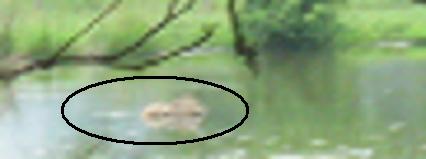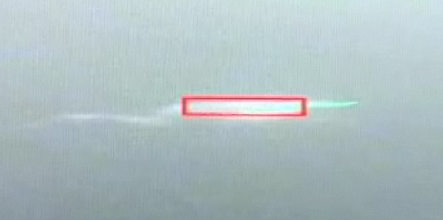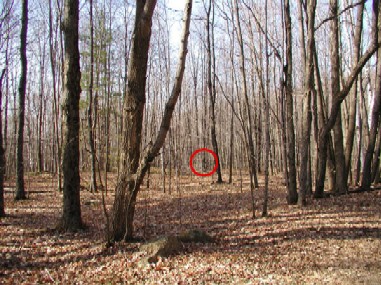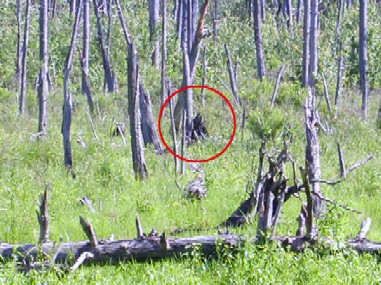The End of Blobsquatchery?
Posted by: Loren Coleman on October 13th, 2011
Click on the two images above for fuller-sized versions. Of course, as blobsquatches, the view of what you are seeing will not be enhanced, only the blurring.

But now, are the final days of Blobsquatchery within view? (See my November 25, 2006 posting, “A Short History of Blobsquatch,” for more background on the coining of the word.)

Miguel and others send the following video news along with the obvious question: “Could Adobe help us put an end to the endless streaming of Blobsquatches and blurry cryptid photos?”
About Loren Coleman
Loren Coleman is one of the world’s leading cryptozoologists, some say “the” leading living cryptozoologist. Certainly, he is acknowledged as the current living American researcher and writer who has most popularized cryptozoology in the late 20th and early 21st centuries.
Starting his fieldwork and investigations in 1960, after traveling and trekking extensively in pursuit of cryptozoological mysteries, Coleman began writing to share his experiences in 1969. An honorary member of Ivan T. Sanderson’s Society for the Investigation of the Unexplained in the 1970s, Coleman has been bestowed with similar honorary memberships of the North Idaho College Cryptozoology Club in 1983, and in subsequent years, that of the British Columbia Scientific Cryptozoology Club, CryptoSafari International, and other international organizations. He was also a Life Member and Benefactor of the International Society of Cryptozoology (now-defunct).
Loren Coleman’s daily blog, as a member of the Cryptomundo Team, served as an ongoing avenue of communication for the ever-growing body of cryptozoo news from 2005 through 2013. He returned as an infrequent contributor beginning Halloween week of 2015.
Coleman is the founder in 2003, and current director of the International Cryptozoology Museum in Portland, Maine.












That is amazing! I’m actually surprised that they didn’t use a blobsquatch for the demo.
Thanks for sharing that video Loren!
Will this be the end of Blobsquatchery? The answer is: Unfortunately not!
I can see where these programs might come in handy in a couple of situations. To be quite honest, there are programs out there now that come close to doing the exact same thing. It might take one twice as long but current programs on the market can almost match this. So my breath is not taken away like the audience in the video.
The first photograph that was retouched or sharpened was due to camera and therefore lens movement. When the shutter of the camera was depressed, the image captured by the lens was effected. Namely, every single pixel in the photograph underwent a dynamic capture that was a constant. The program figured out what movement took place and applied an algorithm to correct the flawed photo. Basically, that requires moving each pixel to a new destination through the mathematical formula or algorithm. Basically, move pixel x over 4 spaces to the right and down 3 spaces, repeat for each pixel.
The second photo example was of text in low light conditions. Again, programs that have been out on the market for sometime would yield similar results. I’ve used similar programs to capture and read license plate numbers for clients that were as blurry as that telephone number in the video example. So I am not “ewing” and “awing” that, as the audience did.
The last photo example was a photograph of a man, taken in low light conditions. The blurring of the photo was probably the result of the camera not being dialed in at the correct ISO number or perhaps due to a slower than shutter speed with a hand held camera. Again, an easy fix with current software. I am not too excited about it as the technology already exists to accomplish this feat.
The real question is, how will this end Blobsquatchery? Well, the problems with blobsquatch photos is much different than the problem with these photos in the video that were corrected.
Most of the blobsquatch photos have a different causative factor for the resulting blobsquatch. Some are underexposed too severely to bring out adequate detail. Several digital manipulations need to be performed to get a somewhat decent image and even then, it may still be unrecognizable.
Another problem is that the incorrect lens is used in trying to get a photo and the result is a small number of pixels creating the blobsquatch. When magnified, it still looks blurry to the viewer because there are probably as many pixels creating the blobsquatch as I have fingers and toes. Seriously, 20 pixels is not going to result in a clear photograph of anything with any software currently available on the market. And the algorithm used the program above is not going to fix that problem. It is what it is.
Lastly, some of the blobsquatch photos I have seen are based on movement of the subject and not the lens. All of the examples in the video were due to some factor resulting in blurred images from “lens movement”. In the case of some blobsquatch photos, the lens is steady giving great detail of the foreground or background but the subject is blurred from the subject moving. When walking, the subjects arms are going to move at a different speed than the feet or body. The arms might go one way and the legs another. A simple algorithm will correct the image if the entire lens is moved, resulting in the blurred image. However, that same algorithm will not correct vertically moving legs and horizontally swinging arms. Not to mention the wind blowing leaves and grass, etc. Sure, maybe you could apply the algorithm to separate parts of the subject and combine the resulting images. But, and this is a big “but”, if there is not enough pixelation making up the blobsquatch, it won’t matter anyway or what great algorithm was applied to the photo in hopes of correcting it.
I think it is great that some headway is being made by Adobe. I applaud their efforts to make the photographer’s life a little easier. And surely, these programs will save some time in some rare cases of misfortune with incorrect camera settings. However, practically speaking, this technological advancement is not going to clear up blobsquatch photos or make them a thing of the past, at least not in the near future.
Unfortunately, I think we will have several more years of blobsquatch photos coming our way. You know, a good camera, telephoto lens, and a steady hand will trump this technology any day of the week. But alas, it seems to me 99% of the BF hunters out there have inferior equipment, mediocre lenses and shaky hands.
Just my two cents!
“I’m always careful of two kinds of people, the debunkers who have no interest [in openly looking at the evidence]”–If anybody here ever finds evidence of a guy feeding blueberry muffins to a bigfoot, I’ll be happy to look at it.
PhotoExpert: thanks for the illumination.
Everyone thinks that whizbang technology should have brought the sasquatch to light years ago. Everyone neglects to remember that it’s not the technology, but what one brings to it, and how it is used.
Heh, but, but what with the hoaxers who rely on movement blur to make their movies do????
Serious, it sounds wonderful. But I will say, I’m rather fond of blobsquatch for their amusement value, without them, debate will be less colorful. 😛
Well, ain’t you a regular party pooper, PhotoExpert? 🙁
Nah, I kid. I’m very thankful this forum relies on someone with your expertise to share his knowledge about photography.
So maybe this new tool Adobe is developing will not become the ‘magic wand’ —Photoshop has one already 😉 —that will allow us a 100% certainty with every single Blobsquatch photo. But I still think it’s a good example of how technology will keep empowering the average user with even more powerful resources, which —if applied correctly— will greatly enhance the quality of evidence gathered by serious cryptozoologists.
Then again… maybe even after Adobe manages to include all sorts of whistles and gizmos, and hunters go into the woods carrying state-of-the-art photographic equipment, we might STILL be getting nothing but blurry Blobsquatches. I guess we’ll all be owing Nick Redfern an apology then 😛
Who need Photoshop when all you need is Facebook Finding Bigfoots yellow pen.
PhotoExpert: I was eagerly awaiting your take on the matter; thanks for you input.
Alas, it appears “too good to be true” raises its ugly head again and the “blobsquatches,” intentional or not, will continue to haunt us for, at least, the foreseeable future… 🙁
The whole point of bigfoot is an endless elusive quest. When Adobe releases these more impressive photo sharpeners than bigfoot photographers will have to come up with better costumes, more obscuring foreground foliage, more degraded photos that are sharpening resistant, etc…
In the short term better costumes are the way to go. Eventually, rogue scientists will be able to approximate what people will accept as a bigfoot and create one.
It is surprising that effect studios don’t get involved in these hoaxes. It obviously boils down to money and time. Why waste money and effort if there is not a way to at least recoup expenses. Still, there have noticeable improvements to make-up/costume fx since the Patterson-Gimlin footage was taken. It would be interesting to see some modern professional bigfoot material instead of this blurry, obscured nonsense.
It seems to boil down to the fact that there are few artistically talented people who are also interested in pulling of bigfoot photos. You have to have some artistic talent(or money for an untraceable costume) AND the desire to create bigfoot photos.
Surprisingly, photos shot in the late ’60s are the best bigfoot shots we’ve seen so far. Professional effects people need to get involved to create unique costumes made under secrecy. Mass produced store bought ones that are made by pros are traceable.
These weekly fuzzy obscured nonsense photos taken by untalented folks only fool a small percentage and get very tiresome.
DWA–Hey brother! How are you doing? I hope all is well. Afterall, we have been friends on Cryptomundo for several years now and it is always great to see you posting. You hit the nail on the head. It is not the technology but rather, what one brings to it. Of course when technology fails to illuminate a photograph of a blobsquatch, we always can rely on highly intelligent Crytomundians like you to bring things to light. You always do! As you know, I have been a fan of your postings–all of them! Keep up the good work and keep giving the newbies here insight into all things Crypto!
red_pill_junkie–Hey! How have you been? It seems a lot of the great regular and long time posters are showing up in this thread. I love the humor in your posts! I especially like what you said in your post here. You always use humor and then go in with the teachable moment! You also always put things into perspective and you do so from both sides of the coin or argument! Oh, by the way, your responses in the last two Bigfoot related posts I read was awesome and spot on.
Arewethereyeti–You are very welcome! I always try to take the complicated BS technological terms out and replace them with everyday words or examples that even a layperson can understand. Hopefully, when I am done translating, it makes some sense to the readers here at Cryptomundo. I definitely appreciate the feedback! I also think you are spot on when you posted that, “Alas, it appears “too good to be true” raises its ugly head again and the “blobsquatches,” intentional or not, will continue to haunt us for, at least, the foreseeable future…”
So where do we go from here? I think it is going to take an experienced photographer with quick reflexes and a pretty large wallet to get a decent photograph of a supposed Bigfoot. The photographer’s wallet has to be big enough to at least afford high amateur or professional photographic equipment. I don’t think we are going to get any decent photograph from just some Bigfoot enthusiast out there actually looking to get a Bigfoot photo. Many times, in reported Bigfoot encounters, it is a hiker or camper that unexpectedly stumbles upon a possible Bigfoot. This is where the quick reflexes come in. The experience comes in when the photographer sees the Bigfoot and then using his lifetime acquired knowledge and experience, to change the camera settings to get the most perfect shot possible.
I have written about this before in prior threads and my opinion has not changed. If we are ever able to get something better than a blobsquatch photograph, I think it is going to be from an avid photographer, who is already in the area and actually seeking to photograph another known anima such as bear, elk, birds, etc. Eventually, a supposed Bigfoot will ramble by. The Bigfoot will see the photographer and become aware about the same time the photographer becomes aware. The photographer will have seconds to adjust, overcome fear or apprehension, dial in the correct settings, compose and shoot the photograph with a steady hand. It will probably happen in low light conditions, making the task all that more difficult. But maybe, just maybe then, we will get a decent photo and not a blobsquatch.
I used the words “supposed Bigfoot” above because there is always the possibility of some hoaxer in a suit, trying to pull a fast one on an innocent photographer. It will be up the jury, those here at Cryptomundo, to give their verdict on those photographs. I think this is what makes cryptozoology a participatory club. Everyone will have input. That input will be from different frames of reference for each juror. And together, a verdict can be reached. Hopefully, there will be no hung juries!
Man, I love Cryptomundo! I also love the air of professionalism that is brought to this site by Loren, Craig, Mystery_man, John Kirk, and all the members of Cryptomundo!!!
Fully agreed with Photoexpert: this plugin specifically address camera shake, which is a major issue with smaller “pocket” digital cameras and cell phone cameras. It’s going to be a great tool -after all, that’s a huge market- but it won’t do anything for images that are actually out of focus, low resolution or shot with insufficient lighting.
Higher resolutions in mobile phone cameras today often make them the first choice for snapshots, but most people don’t realize their limitations. Miniature CCD’s (the chip that actually records the image) aren’t very tolerant to low light, and even if you can record a nice big 7 megapixel image it’s going to be fuzzy if the lens on the back of your phone is covered in fingerprint smudges. Pretty much nothing is going to fix that.
I’m pretty sure that the “blobsquatch” is going to be around for a long, long time.
While there has been several programs out to reduce blur and noise, Adobe seems to have made a quantum leap here.
What is fascinating is with any unknown animal, you eventually find one sooner or later. The fact that a supposed population of 1500 to 2000 are said to exist and have almost never been filmed is extremely interesting. It cannot be an animal anymore than man is considered to be an animal. It has to be another catergory altogether. They must have a sensory capacity far superior to man. And an intelligence at least equal to man if not superior. I think “we” are the missing link, and not them. We may be an intentional hybrid between them and something extraterrestrial. A genetic experiment in isolation to colonize this planet by something that cannot remain here indefinitely. We would be an agent for another intelligence that wants to control of the planet. Possibly at some distant point in the future the planet may be a stepping stone for control of a sector of space. Aliens may be moving through vast stretches of time seeding planets to maintain control of certain areas of space. As aliens may have designed our form, they may have a wholesale avenue for controlling us like a farm animal. As we experiement to build robots to handle certain jobs. They may be doing the same with us. We may be their robot servants of flesh.